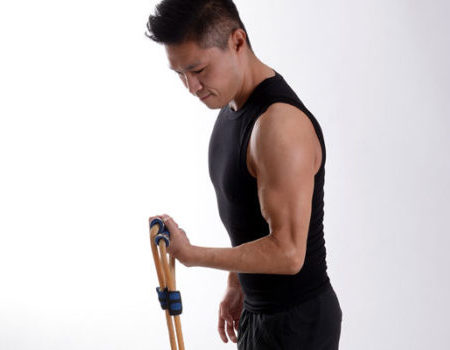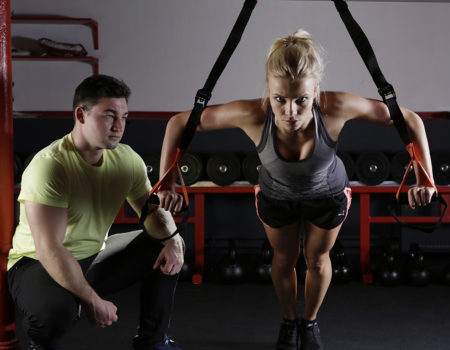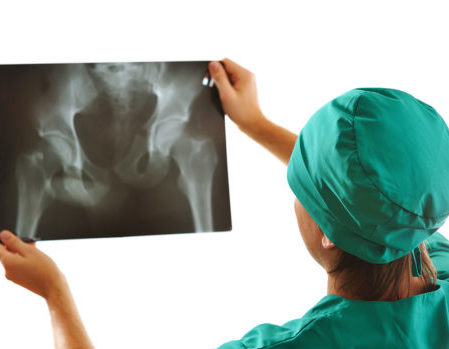Tibiotalocalcaneal Arthrodesis “Techniques in Orthopaedics”
Aug 21, 2019George Edward Quill, M.D. (Retired 2023)
Since the end of the 19th century, arthrodesis has been an accepted treatment for painful arthritis of the ankle and subtalar joints.3 For the purpose of this and other orthopaedic articles, surgical fusion of the ankle (tibiotalar) and subtalar (talocalcaneal) joints at the same operative sitting is termed tibiotalocalcaneal arthrodesis. Fusion of the talus to all the bones articulating with it (distal tibia, calcaneus, tarsonavicular, and cuboid) is termed pantalar arthrodesis and is outside the intended scope of this publication.13, 20Numerous techniques exist describing fusion approaches and implants, all having in common a similar goal: a solid, pain free arthrodesis in a biomechanically stable and functional position.1-31
Indications for tibiotalocalcaneal arthrodesis include avascular necrosis of the talus and failed total ankle arthroplasty with subtalar intrusion.14,16,20,21 A failed ankle fusion with insufficient talar body, as well as patients with rheumatoid or osteoarthritic involvement of these joints are also candidates for tibiotalocalcaneal fusion.8,16,23,25,30 Other indications include the sequelae of trauma and the severe deformity of untreated clubfoot and neuromuscular disease.5,7,20,23,24 Patients with Charcot arthropathy, skeletal defects after tumor reconstruction, pseudarthrosis, as well as fixed or flail deformities about the hindfoot and ankle are also candidates for tibiotalocalcaneal arthrodesis.4,9,18,20,22,27,28
Contraindications for tibiotalocalcaneal arthrodesis include a dysvascular extremity or one that has a severe active infection.10, 15Fusion of the ankle and subtalar joints employing medullary fixation inserted through the sole of the foot is contraindicated in the patient with an insufficient plantar weight bearing surface for padding. Severe fixed deformities of the ankle, hindfoot and distal tibia are relative contraindications for the closed nailing technique for arthrodesis because of the difficulty encountered in obtaining a collinear reduction of the distal tibia, talus, and calcaneus.
The purpose of this article is to provide a relevant history of the methods and results employing tibiotalocalcaneal arthrodesis. The most successful surgical techniques in performing tibiotalocalcaneal arthrodesis are described. The results and personal experience gained by the author in his own clinical series of more than 40 patients undergoing this procedure will be presented.
History of Tibiotalocalcaneal Arthrodesis
Ankle arthrodesis was first reported by Albert in 1882.3 Numerous reports in the English and German literature describe various techniques and offer clinical results for this procedure.1-31 Fusion of the tibia to the talus and the talus to the os calcis has been performed using posterior extra-articular methods employing techniques described by Staples.26 Intramedullary fixation for tibiotalocalcaneal arthrodesis is not a new concept. In 1906 Lexer described a technique which consisted of placing a boiled corpse bone pin through a hole in the calcaneus, talus, and tibia.19 In 1915 Albee used the fibula as a vertical spike to perform an ankle and subtalar fusion.2 Adams, Leikkonen, Küntscher, and Bingold described techniques for tibiotalocalcaneal arthrodesis in the late 1940’s and the mid-1950’s.1,6,17,18 In a German text entitled “The Practice of Intramedullary Nailing”, published in the 1950’s and 1960’s, Gerhardt Küntscher described a method of combined arthrodesis of the ankle and subtalar joints. He employed a technique of closed medullary nailing with a conical nail inserted over a guide pin through the sole of the foot. He felt that extensive destruction of the joint and nailing should be done simultaneously. He used a 12 to 14 millimeter nail to achieve an interference fit, and no locking of the nail was done. Patients were kept at bed rest for three weeks and then ambulated in plaster.17
In 1979, Tomeno presented 45 pan-arthrodeses using various fixation techniques, but with a very high infection rate. He had an 80 percent consolidation rate.29 Russotti and Johnson reported in 1988 on 21 tibiotalocalcaneal arthrodeses employing Steinmann pins and external fixation. Radiographic union was achieved in 85 percent of these patients with satisfactory results and 75 percent employing a posterior Achilles splitting approach.25 Papa and Myerson published a series of 21 pantalar and tibiotalocalcaneal arthrodeses for osteoarthrosis.23 They achieved an 86 percent fusion rate using a transfibular approach with cannulated screws for fixation. These same authors also had two patients who underwent tibiotalocalcaneal arthrodesis in a neuropathic fusion series. Both of these patients fused in under five months using a cannulated screw technique.22
Drs. Johnson and Gehrke returned to using an IM nail for tibiotalocalcaneal fusion in a presentation given at the 1993 Summer Meeting of the American Orthopaedic Foot and Ankle Society and later published by Kile, et al.14, 15 They positioned the patient prone and used an Achilles splitting approach, but they initially claimed that the technology involved in using the nail was more involved than other established techniques, and that the long-term results were not known as yet.
This author prefers to perform tibiotalocalcaneal arthrodesis using an intramedullary nail for fixation. This nail is placed percutaneously and combined with arthrotomy and debridement of the ankle and subtalar joints. The nail is placed trans calcaneally through the talus into the tibia and locked proximal and distal to these joints with transfixation screws.
The intramedullary nail employed by the author in a series of 40 tibiotalocalcaneal arthrodeses is a fully cannulated, stainless steel closed section nail that is available with 11, 12 or 13 millimeter outer diameters in lengths of 15 centimeters, 17 centimeters, 20 centimeters, or 25 centimeters. The first two, distal holes are located 15 millimeters and 30 millimeters from the driving end for good calcaneal and talar fixation. A third distal screw is also present and can be used to gain purchase of the talus or the supramalleolar distal tibia. The transfixing holes are locked with 5 millimeter fully threaded screws, and interlocking holes are available proximal to the ankle for proximal fixation (Figure 1).
The nail employed in this series has an 8 degree bow in the parasagittal plane. Taking advantage of this bow and directing the bow’s apex posteriorly, the surgeon can employ a subcalcaneal insertion point anterior to the weight-bearing surface of the os calcis.
Surgical Technique
The patient is positioned supine on a radiolucent operating table with a well-padded bump under the ipsilateral buttock in order to internally rotate the involved extremity. We place another bump under the heel so that cross-table fluoroscopic imaging is facilitated. General or spinal anesthesia is used, and a thigh tourniquet greatly facilitates the plantar dissection. Intraoperative C-arm fluoroscopy is used as indicated.
An anteromedial or anterolateral ankle arthrotomy is used in order to correct what deformity may be present across the tibiotalar joint and to prepare the joint surface by removing what is left of the articular cartilage. Using an anterolateral approach, the surgeon can quite readily extend the incision to the subtalar joint, also exposing and debriding this joint before medullary fixation. These arthrotomies also allow the surgeon a site for inserting bone graft if he feels it is necessary.
In cases of inflammatory arthritis such as rheumatoid disease, subtalar arthrotomy may not be necessary. The surgeon may want to consider a fibular osteotomy at the time of hindfoot fusion if there is a significant varus deformity or loss of tibial length relative to the fibula. If the fibular osteotomy is not done in these cases, then the fibula may actually hold the tibiotalar and talocalcaneal arthrodesis sites distracted postoperatively.
A longitudinal plantar approach is used, placing the incision slightly lateral to the midline, especially in the patient with significant valgus of the hindfoot and ankle. After the incision is made, blunt dissection is taken down to the plantar fascia, which is split longitudinally. The intrinsic muscles are swept medially or laterally, and the neurovascular bundle is identified at the medial portion of the wound. A sharp awl is used to make a plantar calcaneal corticotomy. The position of the awl can be checked intraoperatively with fluoroscopy. If the awl cannot be readily placed across both joint surfaces, the subtalar and tibiotalar articular surfaces may be crossed with the use of a cannulated drill over its threaded guide wire. This allows access through the calcaneus and talus to the medullary canal of the distal tibia.
This procedure opens up the tibiotalocalcaneal canal enough that a spade-tipped guide wire can be passed into the tibial medullary canal more readily. A series of progressively larger flexible reamers are passed over the guide wire and are used to prepare and enlarge the tibiotalocalcaneal canal, reaming a full to 1 millimeter larger than the anticipated nail’s outside diameter.
The nail is attached to its alignment guide after noting the appropriate direction of the nail’s 8 degree bow. Also before inserting the nail into the foot, the surgeon will note which holes are to be used for interlocking once the nail is inserted. The nail is slightly internally rotated so that when the screws are inserted from lateral to medial they will pass into the tibia, clearing the fibula.
The nail is quite readily inserted manually without need for a guide wire and then impacted. The distal aspect of the nail is countersunk within the os calcis, and usually the distal two or three screws are inserted for interlocking first. This allows good purchase of the foot by the nail and screws, and then further impaction can be done, giving compression across the tibiotalar arthrodesis site before the nail is interlocked in the tibia. The interlocking screws are inserted from lateral to medial using the interlocking alignment device and, when necessary, intraoperative fluoroscopy. This author rarely uses screws longer than 25 millimeters to gain bicortical purchase of the tibia. Locking screw lengths of 35 to 45 millimeters may be necessary to gain purchase of the talus and calcaneus (Figures 2a and 2b).
Clinical Results
Forty patients (25 male and 15 female) with a mean age of 47.6 years (range = 14 to 82 years) underwent tibiotalocalcaneal arthrodesis with intramedullary fixation for diagnoses of osteoarthrosis (25 patients), rheumatoid arthritis (6 patients), pseudarthrosis after failed prior attempts at ankle fusion (3 patients), Charcot arthropathy (4 patients), destructive distal tibial giant cell tumor (1 patient), and rigid talipes equinus resulting from paraplegia (1 patient). With a mean follow-up interval of 30 months (range = 18 to 60 months), a 90 percent union rate was achieved at a mean time to union of 14 weeks.
Complications related to the nail included four instances of painful retained or fractured interlocking screws, four cases of nonunion, one of which was asymptomatic, and a single case of a 20 degree valgus malunion. One ulceration occurred in a neuropathic patient over a fractured interlocking screw, which was subsequently removed. This same patient had posterior tibial nerve entrapment due to that screw prior to its removal. The overall nonunion rate was 4 patients out of 40 or 10 percent. Only 3 of these 40 patients, or 8 percent, had a symptomatic nonunion. These 3 patients have subsequently been revised successfully.
The patients who underwent this procedure for the sequelae of post-traumatic osteoarthrosis had undergone a mean of five prior procedures each before coming to their index tibiotalocalcaneal arthrodesis with medullary fixation. The one patient who had had a giant cell tumor resected had six prior procedures, one of which was an unsuccessful attempt at ankle arthrodesis. This was successfully salvaged with tibiotalocalcaneal arthrodesis by the technique described here.
The results of this series would indicate that intramedullary nailing is a solid method of fixation for tibiotalocalcaneal arthrodesis in appropriately selected patients. We achieved an overall union rate of 90 percent at a mean time to union of 14 weeks in a large series that included patients undergoing tibiotalocalcaneal arthrodesis for a variety of indications. We had a symptomatic nonunion rate of percent.
The best clinical results (100 percent union rate, 0 percent complication rate) after tibiotalocalcaneal arthrodesis with intramedullary fixation have been obtained in non-neuropathic patients undergoing their first fusion procedure for a diagnosis of primary osteoarthrosis or rheumatoid arthritis.
The significance of this report is that a method of hindfoot arthrodesis first described decades ago may be even more successfully employed today with the availability of a better fixation device (intramedullary ankle fusion nail). Fusion rates employing this nail are very high in appropriately selected patients, even in cases of salvage arthrodesis after failures of more conventional techniques of fixation.
Bibliography
- Adams, J.C.: Arthrodesis of the Ankle Joint. Experiences With the Transfibular Approach. J. Bone and Joint Surg., 30B:506-511, 1948.
- Albee, F.H.: Bone-Graft Surgery, Philadelphia and London: W.B. Saunders, p. 335, 1915.
- Albert, Eduard: Einige Fälle von künstlicher Ankzlosen bildung an paralytischen Gleidmassen. Weiner Medizinische Press, 1882.
- Ansart, M.B.: Pan-Arthrodesis for Paralytic Flail Foot. J. Bone and Joint Surg., 33-B: 503- 507, 1951.
- Barrett, G.R., Meyer, L.C., Bray, E.W., Taylor, R.G., and Kolb, F.J.: Pantalar Arthodesis: A Long-Term Follow-up. Foot and Ankle, Volume 1 #5:279-283, 1981.
- Bingold, A.C.: Ankle and Subtalar Fusion by a Transarticular Graft. J. Bone and Joint Surg., 38B:862- 870, 1956.
- Blair, H.C.: Comminuted Fractures and Fracture Dislocations of the Body of the Astragalus: Operative Treatment. American J. of Surgery, Vol. LIX (1):37-43, 1943.
- Carrier, D.A., and Harris, C.M.: Ankle Arthrodesis with Vertical Steinmann’s Pins in Rheumatoid Arthritis, CORR 268:10-14, 1991.
- Casadri, R., Ruggieri, P., Giuseppe, T., Biagini, R., and Mercuri, M.: Ankle Resection Arthrodesis in Patients with Bone Tumors. Foot and Ankle International, 15:242-249, 1994.
- Cierny, G., Cook, G., and Mader, J.: Ankle Arthrodesis in the Presence of Ongoing Sepsis. Orthop. Clinics of North America, 20:709-721, 1989.
- Gellman, H., Lenihan, M., Halikis, N., Bott, M., Giordani, M., and Perry, J.: Selective Tarsal Arthrodesis: An In Vitro Analysis of the Effect on Foot Motion. Foot and Ankle, Vol. 8(3):127-133, 1987.
- Hamsa, W.R.: Panastragaloid Arthrodesis. J. Bone and Joint Surg., 18:732-736, 1936.
- Hunt, W.S., and Thompson, H.A.: Pantalar Arthrodesis: A One-Stage Operation. J. Bone and Joint Surg., 36-A: 349-363, 1954.
- Johnson, K.A., and Gehrke: Proceedings of the American Foot and Ankle Society 1993 Summer Meeting, Intramedullary Fixation for Ankle Arthrodesis.
- Kile, T.A., Donnelly, R.E., Gehrke, J.C., Werner, M.E., and Johnson, K.A.: Tibiocalcaneal Arthrodesis with an Intramedullary Device. Foot and Ankle International 15:669-673, 1994.
- Kitaoka, H.B., and Romness, D.W.: Arthrodesis for Failed Ankle Arthroplasty. Journal of Arthroplasty, Vol. 7 #3:722-784, 1992.
- Küntscher, G.: Combined Arthrodesis of the Ankle and Sub-talar Joints, in Practice of Intramedullary Nailing. Charles C. Thomas: 207-209, 1967.
- Leikkonen, O.: Astragalectomy as an Ankle-Stabilizing Operation in Infantile Paralysis Sequelae. Acta Chirurgica Scandinavica Suplementum 152:13-148, 1948.
- Lexer, E.: Die Verwedung der freien Knochenplastik nebst Versuchen über Gelenkversteifung und Gelenktransplanten. Langenbecks Archive für Klin. Chirung. 86:938, 1906.
- Liebolt, F.L.: Pantalar Arthrodesis in Poliomyelitis. Surgery 6:31-34, 1939.
- Marek, F.M., and Schein, A.J.: Aseptic Necrosis of the Astragalus Following Arthrodesing Procedures of the Talus. J. Bone and Joint Surg., Vol. 27(4):587-594, 1945.
- Papa, J., Myerson, M., and Girard, P.: Salvage, With Arthrodesis, in Intractable Diabetic Neuropathic Arthropathy of the Foot and Ankle. J. of Bone and Joint Surg., Vol. 75 #7:1056- 1066, 1993.
- Papa, J.A., and Myerson, M.S.: Pantalar and Tibiotalocalcaneal Arthrodesis for PostTraumatic Osteoarthrosis of the Ankle and Hindfoot. J. of Bone and Joint Surg., Vol. 74-A #7:1042-1049, 1992.
- Reckling, F.W.: Early Tibiocalcaneal Fusion in the Treatment of Severe Injuries of the Talus. The Journal of Trauma, Vol. 12, No.1:390-396, 1972.
- Russotti, G.M., Johnson, K.A., and Cass, J.R.: Tibiotalocalcaneal Arthrodesis for Arthritis and Deformity of the Hind Part of the Foot. J. of Bone and Joint Surgery. Vol. 70-A #9:1304- 1307, 1988.
- Staples, O.S.: Posterior Arthrodesis of the Ankle and Subtalar Joints. J. Bone and Joint Surg., 38- A (1):50-58, 1956.
- Steindler, A.: The Treatment of the Flail Ankle; Panastragaloid Arthrodesis. J. Bone and Joint Surg., 5:284-294, 1923.
- Stone, K.H., and Helal, B.: A Method of Ankle Stabilization. CORR 268:102-106, 1991.
- Tomeno, B., and Danan, J.P.: Pan Arthrodesis of the Rear of the Foot. Revue de Chirurgie Ortopedique, Vol. 65:433-439, 1979.
- Vahvanen, V.: Arthrodesis of the TC or Pantalar Joints in Rheumatoid Arthritis. Acta Orthopaedics Scandinavia, Vol. 40:642-652, 1969.
- Waugh, T.R., Wagner, J., and Stinchfield, F.E.: An Evaluation of Pantalar Arthrodesis. J. Bone and Joint Surg., Vol. 47-A (7):1315-1322, 1965.
Legends for Figures
- Figure 1: An example of the intramedullary nail used for fixation of tibiotalocalcaneal arthrodeses.
- Figure 2a: Preoperative radiograph of a 41-year-old basketball coach with advanced osteoarthrosis of the ankle and hindfoot.
- Figure 2b: Postoperative radiograph obtained six weeks after the patient pictured in Figure 2a underwent tibiotalocalcaneal arthrodesis with medullary nail fixation and autogenous bone graft.



 Our patients can receive MRI imaging onsite at both our Louisville and New Albany Clinics.
Our patients can receive MRI imaging onsite at both our Louisville and New Albany Clinics. Providing the latest advances in orthopedic surgery is our specialty.
Providing the latest advances in orthopedic surgery is our specialty. We take a unique, multidisciplinary approach to pain management.
We take a unique, multidisciplinary approach to pain management. Our physical therapists use advanced techniques to help restore strength and mobility.
Our physical therapists use advanced techniques to help restore strength and mobility.  We provide comprehensive, conservative care for a wide variety of foot and ankle conditions.
We provide comprehensive, conservative care for a wide variety of foot and ankle conditions. We offer same- and next-day care to patients with acute injuries.
We offer same- and next-day care to patients with acute injuries. Get back in the game with help from our sports medicine specialists.
Get back in the game with help from our sports medicine specialists.  Our centers are equipped with a state-of-the-art digital X-ray machine.
Our centers are equipped with a state-of-the-art digital X-ray machine.